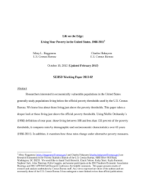Life on the Edge: Living Near Poverty in the United States, 1966-2011
Life on the Edge: Living Near Poverty in the United States, 1966-2011
This paper presents results of research and analysis undertaken by Census Bureau staff. Any views expressed are those of the authors and not necessarily those of the U.S. Census Bureau. It has undergone a more limited review than official publications.
Abstract
Researchers interested in economically vulnerable populations in the United States generally study populations living below the official poverty thresholds used by the U.S. Census Bureau. We know less about those living just above the poverty thresholds. This paper takes a deeper look at those living just above the official poverty thresholds. Using Mollie Orshansky’s (1966) definition of near poor, those living between 100 and less than 133 percent of the poverty thresholds, it compares rates by demographic and socioeconomic characteristics over 45 years (1966-2011). In addition, it examines how these rates change under alternative poverty measures.
Others in Series
Working Paper
Working Paper
Working Paper




